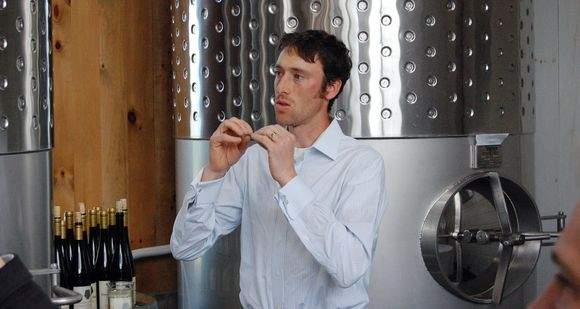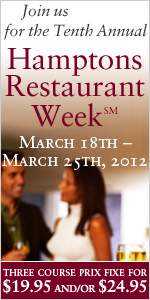
Hermann J. Wiemer winemaker Fred Merwarth discussing his winemaking philosophy
By Remy Charest, The Wine Case
This may not come as that much of a surprise to those familiar with the Finger Lakes, but the region does make really great riesling. For participants in the second edition of Tastecamp EAST, however, this three-day, three-lake stint in the region was a great opportunity to confirm that the region indeed lives up to its reputation in that respect: just like merlot in Long Island – Tastecamp’s first destination, last year – the Finger Lakes' flagship grape consistently delivers.
Throughout the weekend, we had the opportunity to taste a great range of rieslings, made in a great variety of styles, and from vintages ranging from 2001 to 2009. I don’t believe I tasted one I didn’t at least reasonably like, and many were delicious and worth cellaring.
Rieslings from Red Newt, Ravines, Damiani, Lamoreaux Landing, Fox Run, Anthony Road, Heron Hill and others were distinctive, well-crafted and balanced, each in their own distinctive style.
A 2002 riesling from Heron Hill was beautifully aged, with a lot of typical petrol notes and still nice fruit – and the 2007 looked even more promising. Lamoreaux Landing’s three single-vineyard bottlings showed truly distinctive character from site to site, in a crisp, refreshing style with good weight and length. Fox Run rieslings were exotic and fruit-driven, with a capacity to age very well, as demonstrated by a vertical tasting where the 2001s and 2003s still shone. Ravines’ Argetsinger vineyard riesling, bone-dry and mineral, yet aromatic and complex, showed a completely different take on the grape – and was also great with breakfast at its vineyard of origin. I could go on with many other examples: Hunt Country, Sheldrake Point and Three Brothers also had good wines to show.
However, the highlight of the weekend, as far as riesling is concerned (there was also some great pinot from Damiani, Ravines and especially, Hearts and Hands), was a visit to Herman J. Wiemer Vineyard, a winery that has been at the heart of winegrowing in the Finger Lakes since the late 1970s.
Hermann J. Wiemer, who moved from Germany to the Finger Lakes, determined to show the region’s potential for riesling, clearly knew his way around a vineyard and a cellar, and built a solid reputation in the region, even becoming an important source of vines for local growers, in his own nursery.
A few years ago, Mr. Wiemer handed over the reins to a group of young investors, including his winemaker Fred Merwarth. Merwarth's approach shows a willingness to pay careful attention to the specificities of individual vineyards and of the grapes provided by each vintage, and a rare willingness, in the Finger Lakes, to let nature work its way into the fermentations.
Merwarth’s approach offers the closest thing to natural winemaking that I saw all weekend, in a region where the approach tends to be very technical and control-oriented. I almost choked on my wine, one time, when a winemaker seriously stated that to let the local terroir express itself, you had to exert control on every step of the process – including using cultured yeasts to ensure predictable fermentations. Merwarth, thankfully, though he remains careful in his technique, is willing to give his wine more leeway.
When he presses the juice at harvest, he does not add sulfur and lets it aerate substantially, something which likely helps the yeasts present on the grapes to start their work spontaneously. Still, in the first ferment of the season, he uses a cultured yeast, and then takes a bucket from that first tank and pours it into the next to help the fermentation start. His argument is that, by the time you get further down the line, the composition of yeasts has likely changed considerably, giving room to the yeasts present in the vineyard and cellar.
Why not go all the way and let fermentations start spontaneously, I asked him when we were tasting his wines, right by the stainless steel tanks where the wines, in many cases, were still slowly finishing their fermentations at their own – I daresay natural – pace? Giving the juice a little kick-start at the beginning of the process provides him with a “comfort level”, a greater confidence that everything will head in the right direction. A bit of a safety blanket, in other words: it feels like he is just this close to letting natural yeast fermentations start on their own, and I personally would encourage him to do so on a couple of tanks, at least. In fact, there was at least one spontaneous fermentation in his cellar: a barrel of 2009 trockenbeerenauslese, fermented in a barrel that, he says, always starts quickly and reliably and gives great results. Keep it up, I say…
Indeed, the Wiemer rieslings were very distinctive, with a particularly vibrant, expressive character and layers of aromas and flavors that I only found, otherwise, in the Tierce rieslings, a joint cuvée mixing wines from three wineries (Anthony Road, Red Newt and Fox Run) in a particularly successful blending exercise. With the exception of the Frost cuvée, a blend of wines that did not make it to single vineyard or reserve cuvée, and that I personally found a bit too sweet, everything was pretty much impeccable.
The 2008 Dry Riesling had lots of fruit up front, with a mineral layer rising towards a stoney, crisp finish. The 2008 Reserve Dry Riesling was indeed a cut above, with apples and pears blending in over the nice mineral touches: a wine of impeccable balance, created from the best tanks from the various vineyards operated by the winery. The 2003 Reserve, actually all from the HJW Vineyard, located immediately next to the winery (Hermann J. Wiemer had a different approach to his reserve wines), showed apricots and honey and great length: it could still evolve beautifully.
Single vineyard bottlings also showed a distinct personality, with the 2008 Magdalena Vineyard Riesling showing floral notes above the apple, pear and citrus that were at the core of the 2008 HJW Vineyard riesling’s expression. The Magdalena site, ten miles north of the winery, is actually warmer than the Wiemer vineyard, which may explain its slightly more expansive nature. A 2009 tank sample from Magdalena was luscious, with beautiful honeycrisp apple notes, while the HJW seemed a little tighter, even though it still had some residual sugar, as the fermentation was still under way.
On another grape front, good points also go to the 2008 Gewurztraminer, which showed beautiful rose and white peppercorn, with a more open nose and complex expression than anything else I tasted that weekend. Many of the gewurzes I had during TasteCamp reminded me of Thrills “soap” gum, and simply didn’t give the full measure of the grape. This was a welcome exception. Merwarth pointed that he picks those grapes over several weeks, with earlier pickings providing an acidity that otherwise drops quickly, while later-harvested grapes provide a wide range of aromatics. A very successful approach.
With what I tasted, in what was a very friendly, instructive tasting, I would be very happy to keep following what’s going on at Wiemer. Merwarth has a sure hand and a good capacity to listen to what the grapes are telling him. I hope he keeps going further down that path.



Kudos to Fred for continuing to carry the torch at Wiemer. He certainly had very big shoes to fill and the wines continue to inspire.
My question for the science editor is this - do you believe that a cultured yeast that is grown, increased in population and transferred in this way would eventually allow an ambient strain to develop? My understanding is that cultured strains are bred to dominate and in larger populations would not allow a wild yeast population to take hold. Your thoughts?
Posted by: R. Olsen-Harbich | May 22, 2010 at 10:19 AM